proc
round-table {s x y r} {
upvar pi pi
set q [$s get graph]
set n [$s count]
for {set i 1} {$i <= $n} {incr i} {
$q.coords set attribute
\
"as $s index $i" \
[list [expr
$x + $r*cos(2.0*$i/$n*$pi)] \
[expr $y + $r*sin(2.0*$i/$n*$pi)]]
}
}
Graph0.all
erase
Graph0 new node 12
round-table Graph0.nodes 300 300 230
|
|
|
|

|
|
|
Auf dieser Party wollen
sich jetzt alle die Hand reichen.
proc
complete { s } {
set q [$s get graph]
set n [$s count]
for {set i 1} {$i < $n} {incr i} {
$q new undirected edge \
"as $s index $i" \
"as $s index [expr $i+1] $n"
}
}
complete Graph0.nodes |
Dies ist ein vollständiger Graph. |
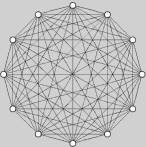 |
|

|
|
|
Wie häufig werden
insgesamt Hände gereicht. Bevor wir lange überlegen, daß
jeder elf anderen die Hand reicht und wir die dadurch jedes Händeschütteln
doppelt gezählt haben, lassen wir zählen:
Dieser Befehl setzt die
Koordinaten aller Knoten auf {200 200}.
|
66 |
|

|
|
|
Natürlich gibt es
auch größere Feiern:
|
Graph0.all
erase
Graph0 new node 30
round-table Graph0.nodes 300 300 230
complete Graph0.nodes
|
|
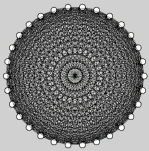 |
|

|
|
|
Beim Shake-Hands
im Falle von Fußballmannschaften, ändert sich das Prinzip:
|
proc
line {s x1 y1 x2 y2} {
set q [$s get graph]
set n [$s count]
for {set i 0} {$i < $n} {incr i} {
$q.coords set attribute
\
"as $s index [expr $i+1]"
\
[list [expr $x1
+ $i*($x2-$x1)/($n-1)]\
[expr $y1 + $i*($y2-$y1)/($n-1)]]
}
}
Graph0.all
erase
Graph0 new as name heim
Graph0 new node 11 in heim
line Graph0.heim 100 100 500 100
|
Die Heimmannschaft:
|
 |
|

|
|
|
Die Gastmannschaft in
Rot:
|
Graph0
new as name gast
Graph0.node_fillcolor set default red
Graph0 new node 11 in gast
Graph0.node_fillcolor set default white
line Graph0.gast 100 500 500 500
|
|
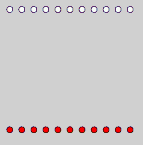 |
|

|
|
Shake-Hands
|
Graph0
new undirected edge {as heim} {as gast}
|
|
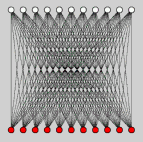 |
|

|
|
Soviel
zum Sport und zurück zur Natur:
|
Graph0
new as name height
Graph0 new as name root
proc tree {r d x0 y0 a s} {
upvar pi pi; upvar b1 b1;
upvar b2 b2; upvar f1 f1;
upvar f2 f2
set x [expr $x0+$s*cos($pi*$a/180)]
set y [expr $y0+$s*sin($pi*$a/180)]
Graph0.coords set default [list $x $y]
Graph0 new node in $r with height $d
if {$d > 0} {
set son [Graph0 new
as]
tree $son [expr $d-1] $x
$y [expr $a+$b1] [expr $s*$f1]
Graph0 new directed edge
"as $r" "as $son" with height $d
$son = {as none}
tree $son [expr $d-1] $x
$y [expr $a+$b2] [expr $s*$f2]
Graph0 new directed edge
"as $r" "as $son" with height $d
$son delete
}
}
|
Sie werden sich jetzt sicher
fragen, was dieses Programm wohl macht. Nehmen Sie sich das als warnendes
Beispiel und kommentieren Sie Ihre Programm(schnips)e(l) sorgfältig
für die Nachwelt (so wie ich...).
|
|

|
|
Die
Auflösung naht... Das ist ein Baum:
|
set
b1 10; set b2 -13; set f1 0.8; set f2 0.7
Graph0.nodes erase
tree Graph0.root 4 300 500 -90 130
|
|
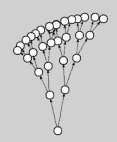 |
|

|
|
Nun
ja. Ziemlich knotig, der Baum. Wir werden ihn etwas liften:
|
Graph0.node_fillcolor
set attribute \
"as height matches 1
4" black
Graph0.node_fillcolor set attribute \
"as height matches 1"
green
for
{set i 1} {$i <= [Graph0.edges count]} \
{incr i} {
set w [Graph0.height min \
"as Graph0.edges
index $i"]
Graph0.edge_width set attribute
"as Graph0.edges index $i" [expr
3*$w+4]
}
|
|
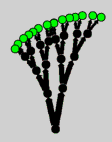 |
|

|
|
|
Für die (Graphen-)
Theorie ist der folgende Baum genau dasselbe wie eben nur größer.
set b1 90; set b2 -90
set f1 [expr pow(0.5,0.5)]; set f2 $f1
Graph0.nodes erase
Graph0.node_size set default 3
tree Graph0.root 6 10 200 0 150
|
Es entsteht wiederum eine
Schleife und eine Kante vom dritten Typ, der zur Verfügung steht:
die ungerichtete Kante. |
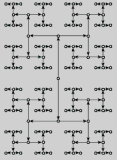 |